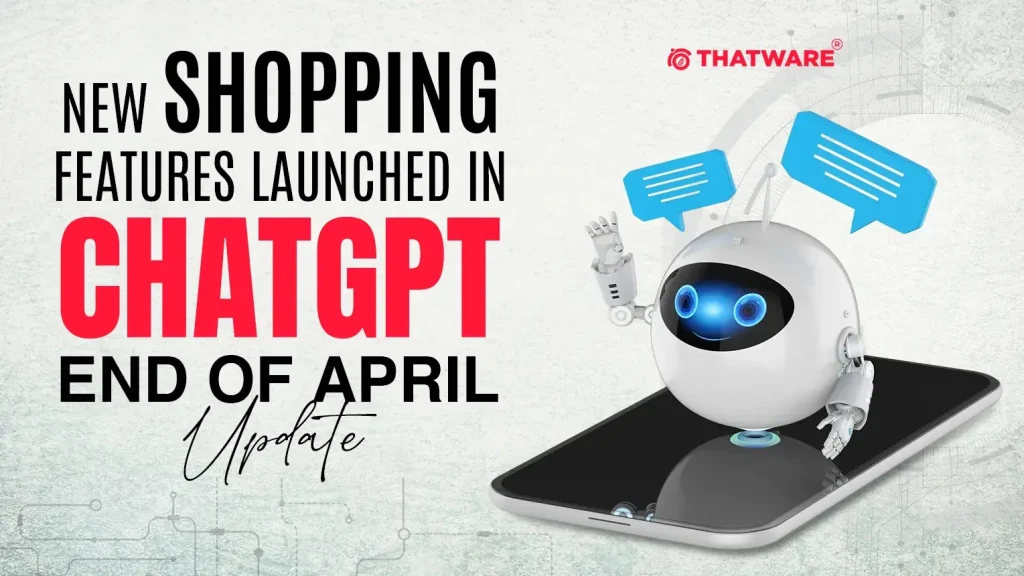SUPERCHARGE YOUR ONLINE VISIBILITY! CONTACT US AND LET’S ACHIEVE EXCELLENCE TOGETHER!
Traditionally, when users search for products on Google, the Search Engine Results Page (SERP) displays product ads and listings sourced from the Google Merchant Center. These are primarily paid placements, where advertisers bid for visibility. However, a groundbreaking shift is now underway—OpenAI has launched a game-changing shopping feature in ChatGPT that is set to redefine how users discover and explore products online.

Starting April 28, 2025, ChatGPT users can now access a fully interactive, ad-free shopping experience directly within the chat interface. Whether you’re using the Free, Plus, or Pro plan—or even if you’re not logged in—this feature is available across all regions where ChatGPT operates.
Key Highlights of ChatGPT’s April 2025 Shopping Feature Update
1. Personalized Product Recommendations
ChatGPT leverages conversational AI and user preferences to deliver tailored product suggestions. This goes beyond keyword-based searches, offering curated results that match your specific interests, lifestyle, and past queries.
2. Detailed, Comprehensive Product Information
Each product suggestion comes packed with in-depth details—including specifications, pricing, features, reviews, and more. All this data is presented in an easy-to-read format, right inside your conversation.
3. Ad-Free Shopping Interface
Unlike Google Shopping or Amazon search results, ChatGPT’s product listings are not influenced by ads or paid placements. The experience is purely organic and unbiased, prioritizing relevance and user value over ad revenue.
4. Direct Purchase Links to Retailers
Found something you like? Every product shown includes a direct link to the retailer’s website, allowing users to go from discovery to checkout with minimal friction.
5. Trusted Data Integration
OpenAI aggregates product data from verified and reputable sources across the web. This ensures that recommendations are not only personalized, but also accurate, reliable, and up-to-date.
Query:
What This Means for the Future of E-Commerce and Search
With this new update, ChatGPT is not just an AI assistant—it’s now a fully functional product discovery tool, rivaling traditional search engines like Google in terms of usability and trustworthiness. For consumers, it brings a smarter, cleaner, and more efficient way to shop online. For businesses, it opens new avenues for organic product visibility without the need for paid ads.
As OpenAI continues to enhance the shopping experience, we can expect deeper integrations with e-commerce platforms, real-time inventory updates, and perhaps even voice-assisted shopping soon.
ChatGPT’s Shopping Experience: A Deeper Look into Its Game-Changing Capabilities
As we delve deeper into the newly released ChatGPT shopping feature, it’s evident that this isn’t just a superficial product listing tool—it’s a full-fledged interactive shopping assistant. What sets it apart is not just its AI-powered intelligence, but the seamless, contextual, and user-first experience it delivers.
Here’s a breakdown of what users can now see and do when browsing products via ChatGPT:
What ChatGPT Offers in Its Shopping Interface
1. Smart Product Recommendations
Each shopping result comes with specific suggestions based on a product’s core features. For instance, if you’re looking at a laptop, the AI highlights whether it’s best for gaming, portability, or professional use. This makes the results not just accurate—but also intentionally relevant.
2. Intuitive Carousel Browsing
The product results are displayed in an easy-to-navigate carousel format, allowing users to quickly scroll through multiple items without leaving the chat. It’s sleek, fast, and user-friendly—no endless page loads or back-and-forth tabs.
3. Rich Product Pages on Click
When you click on a product, ChatGPT unveils an expanded view, including:
- High-resolution images
- Aggregated user reviews
- Comparison of prices across platforms
- Multiple “Buy Now” buttons linked to different retailers
This effectively eliminates the need to open several websites just to get the full picture.
4. Concise Justifications for Each Recommendation
Rather than vague suggestions, ChatGPT provides clear, concise reasons for why a product may suit you—e.g., “Great for frequent travelers due to lightweight design and long battery life.” These quick summaries mimic the efficiency of a personal shopper.
5. Summarized Customer Sentiment
Instead of reading hundreds of user reviews, ChatGPT delivers an overview of common sentiments—like, “Most users praise the durability and fast performance.” This helps buyers quickly gauge reliability and satisfaction levels.
6. Credible Review Sources
The reviews and data are aggregated from high-authority, trusted platforms, ensuring you’re not basing your decision on unreliable or biased feedback.
Why This Feature Disrupts Google Ads—and Boosts SEO
OpenAI’s introduction of native shopping features within ChatGPT marks a profound shift in the way users discover and interact with products online. This isn’t just an add-on to existing tools—it’s a reimagination of the online shopping journey itself.
While Google Ads have long held dominance in paid product visibility, ChatGPT’s organic, conversation-driven interface offers an ad-free, deeply personalized alternative that appeals to high-intent users. For forward-thinking SEO professionals, this shift presents massive upside potential.
Let’s explore why this development disrupts Google Ads—and supercharges SEO:
1. High-Intent Traffic
- Users who interact with ChatGPT’s shopping recommendations aren’t passively scrolling—they’re actively seeking advice, comparisons, or purchase options.
- These are qualified, decision-stage shoppers, offering brands access to traffic that’s already primed for conversion—without paying per click.
Implication: You’re not paying to reach users; they’re coming to you with strong buying signals.
2. Personalized Recommendations Drive Conversion
- ChatGPT doesn’t deliver one-size-fits-all product lists. It adapts suggestions to user needs, budget, and context—just like a real sales assistant.
- This hyper-personalization increases relevance, trust, and ultimately, conversion rates.
Implication: E-commerce brands that optimize content for conversational relevance can create real-time, AI-driven buyer journeys.
3. Greater Visibility for Niche Brands
- Traditionally, top placement in Google Shopping is reserved for the highest bidder. But ChatGPT levels the playing field.
- Niche retailers and DTC brands can now appear alongside global giants, based not on ad spend but content quality and data accuracy.
Implication: Organic merit—not marketing budgets—can now determine visibility.
4. Contextual Trust Building
- ChatGPT doesn’t just list products. It explains why a product fits your needs, what alternatives exist, and summarizes reviews.
- This builds emotional trust and cognitive clarity, two key drivers of e-commerce success.
Implication: Brands that communicate value clearly and conversationally will thrive in this context-rich ecosystem.
5. Faster Path to Purchase
- Forget multiple tabs, filters, and endless scrolling. ChatGPT presents curated, summarized, and well-ranked options in one place.
- This shortens the decision-making journey and accelerates conversion.
Implication: Fewer steps = fewer drop-offs. That’s e-commerce gold.
6. Enhanced SEO Integration with Product Feeds
- AI models love clean, structured, and richly described content—and ChatGPT is no exception.
- Product listings with robust metadata, schema markup, and up-to-date information are more likely to be featured.
Implication: SEO isn’t dead—it’s evolving. Structured content is now your gateway into AI-powered marketplaces.
7. First-Mover Advantage in Conversational Commerce
- Most e-commerce brands haven’t yet optimized for AI-driven interfaces like ChatGPT.
- Early adopters can gain visibility, build trust, and capture long-tail audiences before the competition catches on.
Implication: Now is the time to build authority in this emerging space—and establish dominance early.
8. Data-Driven Content Refinement
- ChatGPT interactions generate insights into what users ask, want, and respond to.
- Brands can use this to refine their product copy, pricing strategy, and UX design, creating a feedback loop for continuous improvement.
Implication: AI isn’t just recommending your products—it’s informing your entire go-to-market strategy.
9. Affiliate and Direct Monetization Opportunities
- Whether you’re a content publisher or product seller, listings in ChatGPT can be tied to affiliate links or direct-to-site purchase flows.
- This opens up passive income streams, lead gen opportunities, and scalable e-commerce monetization models.
Implication: Your SEO-optimized content can now double as a 24/7 revenue engine.
10. 24/7 Sales Support
- ChatGPT never sleeps. It can explain product features, compare options, and answer objections at any hour.
- This provides a nonstop digital sales rep, drastically reducing dependence on live agents or support chat.
Implication: Brands are no longer constrained by office hours or support bandwidth.
How E-Commerce Websites Can Optimize for ChatGPT’s Shopping Listings
With OpenAI’s rollout of shopping features in ChatGPT, the landscape of product discovery is evolving rapidly. Unlike traditional search engines driven by paid ads, ChatGPT prioritizes conversational relevance, organic data, and user-centric content. For e-commerce brands, this opens a massive opportunity to increase visibility and drive conversions—but only if your site is properly optimized for AI-driven discovery.
To maximize your chances of being featured in ChatGPT’s product recommendations, follow these strategic optimization practices:
1. Implement Structured Data Markup
Why it matters: Structured data allows search engines and AI models to better understand your product pages.
Action Steps:
- Use JSON-LD format for schema markup to describe key product attributes: name, brand, price, availability, review ratings, and images.
- Include structured data types like Product, Offer, AggregateRating, and Review.
- Validate your markup using tools like Google’s Rich Results Test or Schema.org validator.
Pro Tip: The richer your structured data, the more context ChatGPT and other AI systems can extract—enhancing your product’s chance of surfacing in natural queries.
2. Enhance Product Descriptions
Why it matters: ChatGPT uses textual content to interpret product relevance and benefits.
Action Steps:
- Write detailed, original, and conversational product descriptions.
- Focus on user intent—what the customer wants to know before purchasing.
- Highlight key features, benefits, use cases, and differentiators.
- Use natural language and long-tail keywords to match how people speak and search.
Pro Tip: Avoid manufacturer-given boilerplate text. ChatGPT favors pages that explain products in a way that’s both helpful and human-like.
3. Optimize for Natural Language Queries
Why it matters: ChatGPT doesn’t just respond to keywords—it processes entire questions and conversational prompts.
Action Steps:
- Think in terms of questions users might ask, such as:
- “What’s the best hiking backpack for beginners?”
- “Which wireless earbuds work best for Zoom calls?”
- Integrate synonyms, context-rich phrases, and varied keyword formats into your content.
- Create FAQ sections on product pages that mirror how users speak.
Pro Tip: Tools like AnswerThePublic or AlsoAsked can help uncover real user queries to guide your content strategy.
4. Leverage User Reviews and Testimonials
Why it matters: ChatGPT draws on public sentiment and review data to assess product quality and trustworthiness.
Action Steps:
- Display genuine, structured customer reviews on each product page.
- Highlight key phrases like “high durability”, “easy to use”, or “great for kids”, which the AI can interpret as qualitative signals.
- Enable review schema so this data is machine-readable.
Pro Tip: Encourage customers to leave reviews by offering post-purchase incentives—these can feed valuable content into the AI ecosystem.
5. Maintain High-Quality Visual Content
Why it matters: While ChatGPT is text-first, visual data supports better search indexing, product perception, and can be pulled in by integrated systems.
Action Steps:
- Use high-resolution product images with multiple angles and lifestyle shots.
- Add descriptive, keyword-rich alt text to each image.
- Include video demonstrations or 360° views if possible.
Pro Tip: Visual media is increasingly being used by AI tools for enhanced recommendations. Optimize now to stay future-ready.
6. Create Informative Blog Content & Buying Guides
Why it matters: Supporting content gives AI models more context and increases topical authority for your brand.
Action Steps:
- Publish blog posts, how-to guides, and comparison pieces around your product categories.
- Include internal links to product pages.
- Optimize content using semantic SEO techniques to align with user intent.
Pro Tip: A blog post titled “Top 10 Ergonomic Office Chairs for Long Hours” could help your chair products surface when users query ChatGPT for recommendations.
7. Monitor and Analyze Performance Regularly
Why it matters: Continuous optimization ensures you stay relevant and improve over time.
Action Steps:
- Use Google Analytics, Search Console, or tools like SEMRush and Ahrefs to monitor:
- Organic traffic to product pages
- Click-through and bounce rates
- Keyword rankings and engagement
- Use this data to refine titles, meta descriptions, image alt tags, and content layout.
Pro Tip: Create A/B tests for product page formats to learn what structure AI tools respond to best.
Conclusion: The Future of Shopping Is Conversational—and It’s Already Here
OpenAI’s new shopping feature in ChatGPT, launched on April 28, 2025, marks a turning point in the evolution of online product discovery. No longer confined to ad-saturated search engines or generic e-commerce platforms, users now have access to an intuitive, ad-free, and hyper-personalized shopping experience—available anytime, anywhere, and to everyone.
For consumers, this means faster, smarter, and more trustworthy buying decisions. For e-commerce brands, it’s a golden opportunity to capture high-intent traffic organically—without relying on costly ad bids. By optimizing for structured data, conversational content, and AI-driven discovery, businesses can now position themselves front and center in a radically new era of search: conversational commerce.
In a digital landscape being rewritten by AI, ChatGPT’s shopping experience is more than a feature—it’s a strategic shift. The brands that adapt first will not only stand out—they’ll define the future of how we shop online.

Thatware | Founder & CEO
Tuhin is recognized across the globe for his vision to revolutionize digital transformation industry with the help of cutting-edge technology. He won bronze for India at the Stevie Awards USA as well as winning the India Business Awards, India Technology Award, Top 100 influential tech leaders from Analytics Insights, Clutch Global Front runner in digital marketing, founder of the fastest growing company in Asia by The CEO Magazine and is a TEDx speaker and BrightonSEO speaker.

